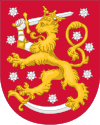Finland during the Great Northern War
Finland during the Great Northern War was dominated by the Russian invasion and subsequent military occupation of Finland, then part of Sweden, from 1714 until the treaty of Nystad 1721, which ended the Great Northern War. The period is also referred to as den stora ofreden ("the great discord") in Swedish or isoviha ("the great hatred") in Finnish. It was previously also called venäläisen ylivallan aika ("era of Russian domination" or "era of Russian supremacy") in Finnish.
Background
Finland was left largely to fend for itself after the disaster of Poltava in 1709. Russia captured Viborg (Russian: Выборг (Vyborg), Finnish: Viipuri) in 1710 and already in 1712 started their first campaign to capture Finland which ended in failure.[1] A more organized campaign starting in 1713 managed to capture Helsinki/Helsingfors and drive defending Swedes away from the coast.[2] The Swedish army in Finland was defeated in Storkyro (Isokyrö) in February 1714 where the Russians won a decisive victory.[3] Swedish efforts to hinder the Russian advance by blockading the coastal sea route at Hangö ended in failure in late July in battle of Gangut. The presence of a Russian galley fleet in the Gulf of Bothnia forced, in the end, both the Swedish fleet and army to largely abandon Finland in late 1714.[4] Even the Swedish areas on the western side of the Gulf of Bothnia were ravaged by the Russians. The city of Umeå was burned to the ground by the Russians on 18 September 1714, and after struggling to rebuild was razed again in 1719, 1720, and 1721.
Russian occupation of Finland
After the victory in Battle of Storkyro, Mikhail Golitsyn was appointed the governor of Finland. Finns began waging partisan warfare against the Russians. As retaliation, the Finnish peasants were forced to pay large contributions to the occupying Russians (as was the custom in that time). Plundering was widespread, especially in Ostrobothnia and in communities near the major roads. Churches were looted, Isokyrö was burned to the ground. A scorched earth zone several hundred kilometers wide was burned to hinder Swedish counteroffensives. At least 5,000 Finns were killed and some 10,000 taken away as slaves, of whom only a few thousand would ever return;[5] According to newer research the amount of those killed is closer to 20,000.[6] Thousands, especially officials, also fled to the (relative) safety of Sweden. The poorer peasants hid in the woods to avoid the ravages of the occupiers and their press-gangs.[7] Atrocities were at their worst between 1714–17 when the Swedish Count Gustaf Otto Douglas, who had defected to the Russian side during the war, was in charge of the occupation.
In addition to the predations of the Russian occupants, Finland was struck – as were most other Baltic countries at the time – by the plague. In Helsinki, 1,185 people died: nearly two thirds of the population. Plague already had struck Finland before the Russian invasion, sapping the strength of Sweden in Finland.[7]
Consequences
It took several decades for the Finnish population and economy to recover after the peace in 1721, at which point Finland was scourged again during the war of 1741–43, although less devastatingly.
See also
References
- Mattila 1983, p. 27–33.
- Mattila 1983, p. 33–35.
- Mattila 1983, p. 35.
- Mattila 1983, p. 38–46.
- Suomen historian pikkujättiläinen. ISBN 978-951-0-14253-0. Page 265.
- "Helsingin Sanomat Kuukausiliite 7/2009, s. 28–33
- Uppslagsverket Finland, 1985
Bibliography
- Mattila, Tapani (1983). Meri maamme turvana [Sea safeguarding our country] (in Finnish). Jyväskylä: K. J. Gummerus Osakeyhtiö. ISBN 951-99487-0-8.CS1 maint: ref=harv (link)
- Svenska slagfält, 2003, (Wahlström & Widstrand, ISBN 91-46-21087-3)
